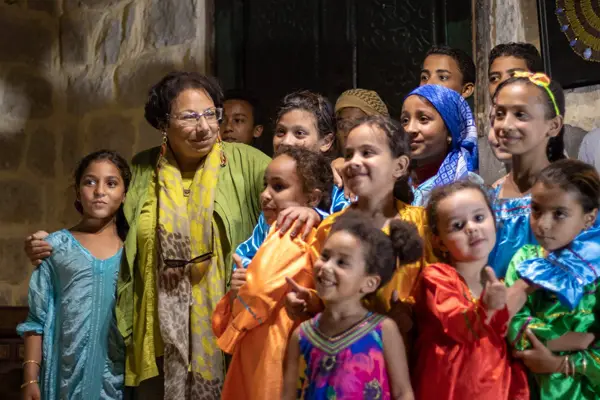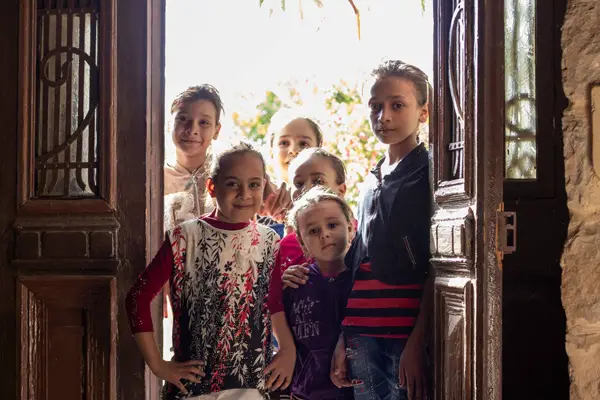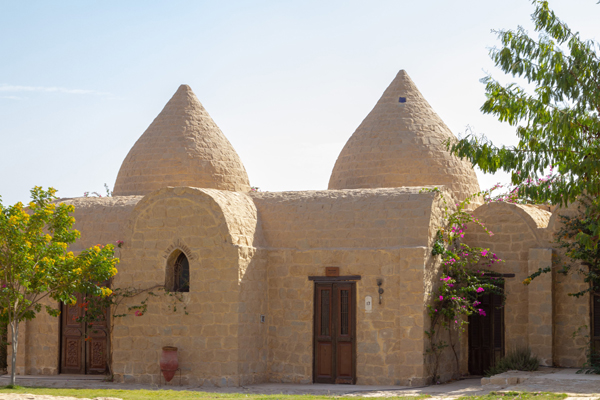Wednesday February 13, 2019 By: Nahed Nasr
WoE – Al Ahram Weekly

The fourth Thoth Festival opened on 26 October, 2019 at New Hermopolis, a non-profit development founded by Mervat Abdel-Nasser in the town of Tuna Al-Gebel, the site of the necropolis of Khmun (aka Hermopolis Magna). This was the western part of the ancient city named after Hermes, the Greek incarnation of the Egyptian god Thoth, whose eastern part is present-day Al-Ashmunein, not far from another important ancient site, Al-Amarna. New Hermopolis is 20km from the city of Mallawi and within the jurisdiction of the Mallawi municipality in the governorate of Minya, and its aim is to fuel cultural and economic activity in Middle Egypt.
The annual event is a revival of an ancient festival thought to celebrate the Word, whose inventor, the god Thoth (aka Dhwtj, meaning “He is like the ibis”) — who also played a crucial role in the underworld — was worshipped at Hermopolis. The month of Thoth, known in Egyptian Arabic as Tut, is the first month of the year on the Coptic calendar and it corresponds to the period 11 September-10 October on the Gregorian calendar, but this year the festival was held in the second half of October to commemorate 45 years since the death of Taha Hussein (on 28 October 1973). Hussein, whose status in modern Arab letters is such he is known as the Dean of Arabic Literature, was a native of Minya, having been born in a village near Maghagha, not far from Mallawi.

According to Abdel-Nasser, Hussein was drawn to Tuna Al-Gebel following archaeological discoveries made there by Egyptologist Sami Gabra, a friend and relative of his. As minister of education in 1951, much later in life, Hussein was to play a pivotal role in retrieving and preserving the Nag Hammadi library. But he is said to have written the novel, The Nightingale’s Prayer (1934, made into an eponymous film in 1959), inspired by the story of Isadora (the Greek girl who drowned herself in the Nile for love) during his stay at Hermopolis, where the rest-house he occupied still stands alongside the one in which Gabra lived. Tuna Al-Gebel is the site of Isadora’s tomb and that of Petosiris (aka Ankhefenkhons), the high priest of Thoth, as well as the catacombs containing the mummified remains of the two animals sacred to the god, the ibis and the baboon.
“This festival seeks to connect the ancient to the modern world, and in each round the majority of the audience are Tuna Al-Gebel families, whose children often participate in the programme.” This year a young male cast performed part of the legendary puppet operetta Al-Laila Al-Kebira, written by Salah Jahin with music by Sayed Mekkawi and puppets by Nagui Shaker who passed away last August. The programme also included the screening of a short documentary on Shaker by Youssef Nasser, Sculpting Time. “It is kind of meeting of history and the future at a site of knowledge and enlightenment.” The poem that Syrian poet Nizar Qabbani dedicated to Hussein was recited by Abdel-Nasser herself, who revealed that the event also marks the 45th death anniversary of her own father, an army surgeon from Minya who died on the front in the course of the October War. “The idea of New Hermopolis was born many years ago, however, long before I decided to take early retirement from my work in the UK and come back to Egypt.”
Indeed the story of the development is the story of Abdel-Nasser’s life. A 1976 graduate of Cairo University’s medical school, Abdel-Nasser worked as a clinical and university psychiatrist in the UK for 30 years (1977-2007), becoming a fellow of the Royal College of Psychiatrists having earned an MA in philosophy and PhD in psychiatry as well as diplomas in moral philosophy and history of medicine from London University. It was during her early years in England that she noticed how much more the British knew about ancient Egypt than Egyptians, especially children.

“The fact shook me. I could see the size of the gap between us and our history, and I thought this must be the reason for the cultural crisis we’re in now. Our history was taken away from us, reduced to a tourist attraction that provides us with some income, as if this civilisation happened here by accident. What is our real connection to these treasures and how can we change the sad reality of our divorce from ancient Egypt, this seemed like the biggest challenge. And so began my journey back in time, fuelled by Egypt’s decline and the spread of fanaticism and terrorism as of the 1970s. The assassination of Farag Fouda and the attempt on Naguib Mahfouz’s life, for example.”
One of her earliest projects was the 40-volume illustrated children’s Encyclopaedia of Ancient Egypt, targeting the eight-15 age bracket, published by Dar Al-Kitab Al-Masri (1997-2002) and republished by the national project, the Family Library (2004-2008), having won the Suzanne Mubarak award for best children’s book in 1998. It takes an integrative approach to its various subjects.
“When we start with ancient architecture,” Abdel-Nasser explains, “we have to end with [the great 20th-century architect] Hassan Fathi, Mahmoud Mokhtar should be placed side by side with the great sculptors of the Pharaohs and Thoth or Dhwtj must be linked with Taha Hussein. We need to show the Egyptian creative spirit is continuous. It is always there, it only needs to be revived.” In the same spirit, the encyclopaedia goes beyond the history of the kings and stresses ordinary people who made great achievements, like Imhotep who became Egypt’s first physician as well as chancellor to the Pharaoh Djoser and [probably] architect of the Step Pyramid. “He is an ordinary Egyptian who became one of the great builders of the Egyptian civilisation. Such examples give us inspiration. Imhotep, whose name means ‘He who comes in peace’, is my idol.”
Abdel-Nasser remains dissatisfied because the encyclopaedia, despite its resounding success and its permanent place in such prestigious libraries as the Bibliotheca Alexandrina, has not been made part of the national school curricula. In addition to her psychiatric books, published in London and New York (1997-2007), Abdel-Nasser has published Arabic books on Horus, Isis, the lotus flower, Imhotep and the meaning of the motherland as well as a three-part History of Ideas and a five-part History of the Ancient World for adults.
But why did she feel the need to retire and head back home in 2007? “Returning to Egypt for the third part of my life was a dream-plan: to do something impactful about the connection with ancient Egypt, to concretise the idea, to present a model, not so much a utopia but the precedent of a space modelled on ancient Egyptian philosophy itself: the belief that humanity is a family that thrives on harmony, balance and acceptance of the other.” This was indeed the guiding principle behind Hermopolis as the capital of the 15th Nome of Upper Egypt, the famous Hare Nome, during which time it was a place of opulence and status second only to Thebes, according to Abdel-Nasser indeed the centre of philosophy and creativity, with close intellectual connections to the Library of Alexandria, whose revival Abdel-Nasser compares to her project in Hermopolis.
Hermopolis is also the site of one of handful of creation myths: the name Ashmunein derives from Khemenu, the ancient Egyptian name of the city, meaning “Eightfold Town”, since the primeval waters developed into the world here thanks to the emergence of the Ogdoad, a set of eight deities who divided into male and female entities before clashing to form the pyramidal mound that is the start of the world. It was their actions, too, that placed the sun in the sky.

For Abdel-Nasser, this myth is the basis of the humanism in which she believes: a human unity that transcends race and sect, a belief in the creative potential of everyone and the possibility of transformation through knowledge. The setting was perfect in theory, but it took three years to settle on an actual spot. Al-Ashmunein had very few monuments apart from the remains of the Temple of Elevated Spirits and the Roman basilica, while Tuna Al-Gebel had the tombs and Hussein and Gabra’s rest-houses. Here too Abdel-Nasser applied her integrative approach, stressing the connection between architecture, agriculture, and culture. A repository of ancient lore, New Hermopolis had to be of direct practical benefit to the town that hosted it, the biggest in Mallawi.
The majority of Minya’s monuments are in Mallawi, Abdel-Nasser says, but the area remains underdeveloped and marginalised. Those who receive higher education tend to leave seeking job opportunities elsewhere, while only the desperate stay. “One of my main targets was to explore alternatives inspired by people who lived here many thousands of years ago.” Thus the idea of rediscovering the Egyptian identity in practical terms: eco-friendly studios and cultural spaces using ancient methods of building in limestone, an incredibly durable material that helps with indoor thermal comfort, requiring less energy. The domes of the ancient Beni Hassan cemetery in southern Minya, which are still used in the Tuna Al-Gebel cemeteries, are also reproduced here to provide tourists with a boutique-hotel experience much closer to the monuments than the Minya city hotels. Such accommodation could help with tourism all across Middle and Upper Egypt: Abdel-Nasser says she can see dozens of possible locations, four other than Hermopolis in Minya.
There is also a five-acre organic farm where the plants cultivated by the ancients — olives, dates, figs — live anew. “The first known Egyptian image of an olive branch can be seen in Akhenaten’s left hand on limestone here in Hermopolis. Ancient Egyptians knew all about desert farming, but today people have lost that edge as they plant demanding crops with a low production rate. I wanted to introduce a different example to benefit Middle Egypt.” This has been obstructed by the lack of a modern infrastructure to support it, however — roads, oil pressing machines, etc — and so the project serves only as a model so far.
New Hermopolis won the 2017 Creative Tourism award 2017, granted by the Creative Tourism Network. It was also on the long list of the African Responsible Tourism Award, 2008, granted by the International Centre for Responsible Tourism — South Africa. But even as she talks of improving facilities and encouraging Egyptian tourists to come to Minya in times of recession like 2011 for example, Mervat Abdel-Nasser still sees her project as primarily a cultural and economic model of sustainability.
“For me New Hermoplois is more of a live centre for sustainable development studies than anything else, based on the most brilliant idea of the ancient Egyptians. The idea of harmony. Light can never kill darkness. Good can never exclude evil, but by widening the circle of good and of light life can be good for everyone. And this is our role. Nothing will be eliminated, but the equation might be adapted a little. The ancient Hermopolis philosophy gives us hope in utopia.”
Until then, we have the Thoth Festival, an opportunity to expand activities and connections, spreading the word about Hermopolis with what limited resources are available.
***If you liked this article, don’t forget to subscribe to our newsletter and receive our articles by email.
